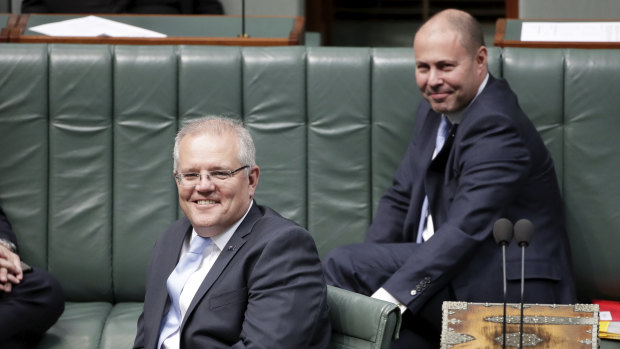This was published 5 years ago
Morrison government moves to surplus as economy slumps to GFC levels
By Eryk Bagshaw and Shane Wright
The Morrison government is on the brink of delivering the first budget surplus in a decade despite the economy slumping to its slowest rate of growth since the global financial crisis and the Prime Minister calling on state premiers to fast-track infrastructure spending.
Declaring there had been a "major improvement" since the budget, Treasurer Josh Frydenberg accused economists and Labor of talking down the economy after national accounts figures showed economic growth had fallen to 1.44 per cent over the past financial year.
Originally forecast to be a $14.5 billion deficit, surging commodity prices have flooded government coffers, with a surplus for the 2018-19 financial year now expected to be confirmed when budget numbers are released by the end of September.
With interest rates at an historic low, the Reserve Bank has spent months urging the government to borrow and spend more to lift economic growth, drive down unemployment and boost wages.
The overall GDP figure, up to a third of the long-run average of between 3 and 4 per cent, has delivered Australia its 29th year of unbroken economic growth. It is the second worst financial year result since the 1991 recession, narrowly pipping the 1.43 per cent recorded in 2002-03.
NSW went nowhere in the three months to June, recording zero state final demand growth. The state's residents have sliced spending on discretionary goods with expenditure on household furnishings alone down by 5.2 per cent.
NSW Treasurer Dominic Perrottet said the downturn in the housing market has obviously had a flow-on effect. "We have seen sluggish growth in household consumption and this has contributed to weaker demand in the last quarter," he said.
The figure which is a broad measure of spending across the state economy that excludes the export sector, was only marginally better in Victoria at 0.5 per cent.
Mr Frydenberg said "we are in a new world" with "low interest rates, relatively low unemployment and low inflation."
The Treasurer said Prime Minister Scott Morrison had written to state premiers about the possibility of bringing forward some infrastructure projects which could provide a boost to the economy.

Prime Minister Scott Morrison and Treasurer Josh Frydenberg.Credit: Alex Ellinghausen
"I want to emphasise that Germany, the United Kingdom, Sweden, Singapore and others experienced negative growth in the June quarter," he said.
"The Australian economy has shown remarkable resilience, and these numbers are a repudiation of all those who have sought to talk down the economy."
Shadow treasurer Jim Chalmers said the government should bring forward its mid-year budget update from December to get the economy out of its rut.
"If the Treasurer thinks that these weak economic growth numbers are good, then he's even more out of touch than we feared," he said
Wednesday's figures showed the household saving ratio fell to its lowest level since December 2007, in a sign consumers are saving less to make ends meet. That's despite overall consumer spending slowing.
New car sales were down 10.1 per cent compared to August last year, with each segment of the market recording a downturn as consumers increasingly avoid expensive purchases.
The figures, released separately by the Federal Chamber of Automotive Industries on Wednesday, show sales of passenger vehicles dropped by 16.7 per cent and SUVs by 5.4 per cent.
"There is no doubt it is a very tough market at the moment," FCAI chief executive Tony Weber said.
Despite the fall, nominal GDP - which feeds directly into the budget - was above expectations with the surge in key commodities set to feed extra cash to the government bottom line. The boost may be short-lived with iron ore prices down sharply since the June quarter.
Amid a bleak international outlook due to the ongoing US-China trade war, mining and international trade were one of the few positives for the economy.
Mining added 0.3 percentage points to the overall 0.5 per cent quarterly result with other support coming from the health and public sector. The manufacturing, construction and wholesale trade sectors cut growth.
The figures highlight the risk of any further deterioration in the global economy with domestic household consumption creeping along by 0.2 per cent due to persistently low wage growth.
The economy would have struggled to stay out of recession without historically high levels of immigration, with economic growth per person - gross domestic product per capita - negative over the past 12 months, the worst performance since 2008-2009.
Ernst and Young chief economist Jo Masters said while the national accounts show an economy still expanding, the pace of growth is slowing and the economy has "lost significant momentum" in the past year.
"Moreover, the growth base is narrow, with growth being driven by net exports and public spending. Private consumption added a little to growth, and private investment and residential construction weighed on activity," she said.
BIS Oxford Economics chief economist Sarah Hunter said growth was likely to "remain relatively subdued until the early 2020s" but she expected the June quarter to be the trough for the year ahead.
The market expects the Reserve Bank to cut official interest rates again before the end of the year to a new record low of 0.75 per cent.